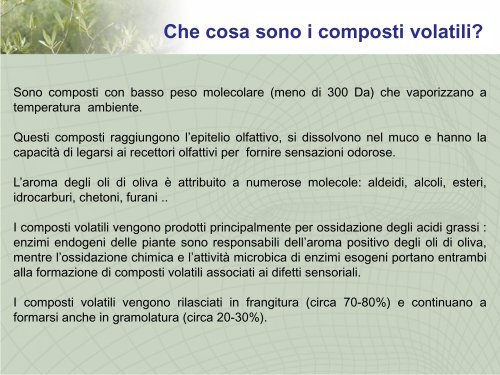Introduzione ai composti volatili degli oli vergini di ... - Archivio ARSIA
Introduzione ai composti volatili degli oli vergini di ... - Archivio ARSIA
Introduzione ai composti volatili degli oli vergini di ... - Archivio ARSIA
You also want an ePaper? Increase the reach of your titles
YUMPU automatically turns print PDFs into web optimized ePapers that Google loves.
Che cosa sono i <strong>composti</strong> <strong>volatili</strong>?<br />
Sono <strong>composti</strong> con basso peso molecolare (meno <strong>di</strong> 300 Da) che vaporizzano a<br />
temperatura ambiente.<br />
Questi <strong>composti</strong> raggiungono l’epitelio olfattivo, si <strong>di</strong>ssolvono nel muco e hanno la<br />
capacità <strong>di</strong> legarsi <strong>ai</strong> recettori olfattivi per fornire sensazioni odorose.<br />
L’aroma <strong>degli</strong> <strong>oli</strong> <strong>di</strong> <strong>oli</strong>va è attribuito a numerose molecole: aldei<strong>di</strong>, alc<strong>oli</strong>, esteri,<br />
idrocarburi, chetoni, furani ..<br />
I <strong>composti</strong> <strong>volatili</strong> vengono prodotti principalmente per ossidazione <strong>degli</strong> aci<strong>di</strong> grassi :<br />
enzimi endogeni delle piante sono responsabili dell’aroma positivo <strong>degli</strong> <strong>oli</strong> <strong>di</strong> <strong>oli</strong>va,<br />
mentre l’ossidazione chimica e l’attività microbica <strong>di</strong> enzimi esogeni portano entrambi<br />
alla formazione <strong>di</strong> <strong>composti</strong> <strong>volatili</strong> associati <strong>ai</strong> <strong>di</strong>fetti sensoriali.<br />
I <strong>composti</strong> <strong>volatili</strong> vengono rilasciati in frangitura (circa 70-80%) e continuano a<br />
formarsi anche in gramolatura (circa 20-30%).




